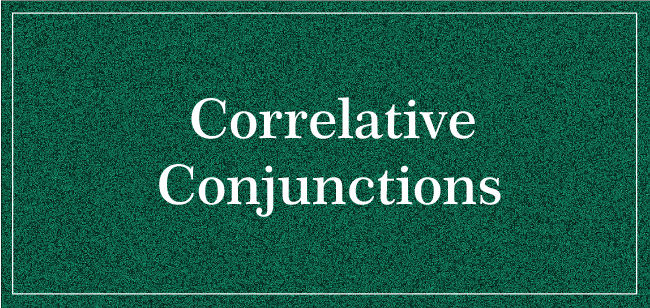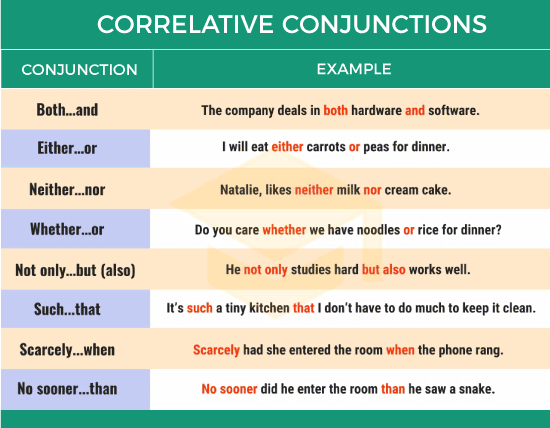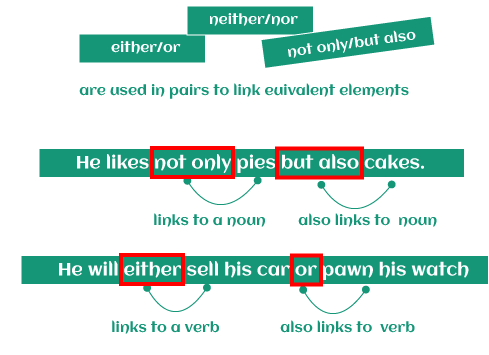Correlative ConjunctionsOne of the 3 kinds of conjunctions is correlative conjunction. (The other kinds of conjunctions are subordinating and coordinating conjunctions.) 
Correlative conjunctions, like all conjunctions, connect words and phrases in statements, showing the relationship (or, in some situations, the absence of connection) between them. You frequently employ correlative conjunctions in daily conversations. You've employed correlative conjunctions when you have ever said anything like, "I could practice either baseball or tennis this season." Correlative conjunctions can help you make your phrases stronger and clearer in your written form. What Is a Correlative Conjunction?Correlative conjunctions are conjunctions that show how two terms or phrases in a sentence are related to one another. Correlative conjunctions are always seen in groups of two. They don't have to demonstrate a connection between the two words or sentences, but they can. The words or sentences connected by correlative conjunction can be analyzed separately in many circumstances. In these cases, connecting them with correlative conjunction shortens your writing and reinforces that the two things being discussed occur in close succession, simultaneously, as a consequence of the same reason, or because they're both distinct options or consequences of a common cause or starting point. Correlative conjunctions function similarly to tag-team conjunctions. They appear in pairs, and you must employ them in different locations in a phrase for them to operate. They got their name from the fact that they collaborate (co-) and connect one phrase constituent to another. Correlative conjunction pairings comprise "both/and," "either/or," "neither/nor," "not/but," and "not only/but also."
Here are some other useful correlative conjunction pairs:
Flipping through these correlative conjunctions cards until you feel like a master is a terrific way to practice these combinations! Conjunctions of Correlatives Connects SentencesSince the sentence parts they link are frequently equal, correlative conjunctions are more comparable to coordinating conjunctions rather than to the subordinating conjunctions. Subordinating conjunctions link independent and dependent clauses that have quite distinct purposes. Correlative and coordinating conjunctions, on the contrary, link words and phrases that have equal merit in the statement. 
"Both/and," for example, relates two subjects or two objects:
The phrase "as/as" compares nouns by using an adjective or an adverb:
The phrase "not only/but also" can link nouns or full clauses:
On the other hand, Correlative conjunctions do more than only link nouns. We may combine verbs, adjectives, adverbs, prepositional phrases, and even clauses based on which ones we employ. In general, commas are not used with correlative conjunctions:
However, a comma may appear next to correlative conjunction if the comma is employed for another purpose, such as splitting off a modifier, a word, or a phrase that informs us more about another word. For instance: The office is considering either Tina, who is an expert in programming, or Tanya, who has a lot of experience for the vacancy. Best Practices for Correlative ConjunctionWhen utilizing correlative conjunctions, there are a few factors to keep in mind. So let us see a few of the best practices or tips for this type of conjunction. 1. Correlative conjunctions link information that is the sameCorrelative conjunctions are employed in sentences to create parallel structures. This implies that they must connect items of similar value. Consider the following statement to get a sense of what I mean: Mario enjoys both playing baseball and football. This statement seeks to link the noun phrases and the infinitive phrases that are not equivalent by using correlative conjunctions. This statement could be changed to equalize two connected components, as in:
Here are some additional statements that employ correlative conjunctions to link unequal objects, followed by potential solutions: Incorrect: We can either go to the playground (verb phrase) or to the wildlife park (prepositional phrase). Correct: We can either go to the playground or go to the wildlife park. (Both the statements are verb phrases.) Correct: We can go either to the playground or the wildlife park. (Both of these are prepositional phrases.) Incorrect: Irrefutably, Jessica would rather win (verb) rather than failure (noun). Correct: Irrefutably, Jessica would rather succeed than lose. (Both of these are verbs.) 2. Subject-verb agreementWhen correlative conjunctions link two singular subjects, the verb is usually single: Neither Olivia nor Jai likes Monday mornings. When correlative conjunctions link two plural subjects, the verb is usually plural: Neither the kittens nor the puppies enjoy washes. When correlative conjunctions link a singular and plural subject, the verb normally agrees with the subject closest to it.
3. Use neither... nor to avoid double negativesWhen employing neither... nor, it is common to inadvertently create a double negative. Since the correlative conjunction pair neither... nor is inherently negative, a sentence containing it does not require a further negative word. Consider the following sentence: Incorrect : Roger did not go to neither the office or the fitness center. If this statement were left alone, it would imply that Roger went to both the office and the fitness center. This is not what the writer wanted to convet when they penned this sentence. Instead, the sentence should read simply: Roger went to neither the office nor the fitness center. Now the statement states that Roger did not go to the office or the fitness centre, This statement is appropriate and accurate and exactly what the writer wanted to say/convey. 4. When separating independent clauses, use a commaDo employ a comma to split two distinct sentences while using correlative conjunction, and prevent employing it to separate the correlative conjunctions themselves. Consider the following sentences: "Neither she, nor you should wear neutral tones," and "Neither she nor you should wear neutral tones." In this case, the latter is right since both subjects are dependent on the same verb, "wear." 5. Check your pronoun agreementWhen utilizing correlative conjunctions, pronouns should comply with their verbs in the same way as subjects and verbs must agree. For instance, "He plays golf" is the acceptable pronoun-verb agreement instead of "He play golf." Whenever the pronoun's antecedent is a component of a correlative conjunction pair, it can be perplexing. Nevertheless, if the sentence has more than one subject, simply employ the pronoun agreement for the nearest noun or noun phrase. Let's look at an example sentence: "Not just my brother, but all of my colleagues were present as well." In this context, "were" refers to a group of "colleagues," as opposed to a single "brother." 
Correlative Conjunction ExamplesLet us have a look at a few examples of a correlative conjunction. Correlative conjunctions have been highlighted in the following examples for easier identification.
Thus, conclusively always use a pair of correlative conjunctions to illustrate the link between two equal parts in a statement. Last but not least, put what you've learned into practice to master the notion of conjunctions and correlative conjunctions.
Next TopicSubordinating Conjunction
|
 For Videos Join Our Youtube Channel: Join Now
For Videos Join Our Youtube Channel: Join Now
Feedback
- Send your Feedback to [email protected]
Help Others, Please Share









